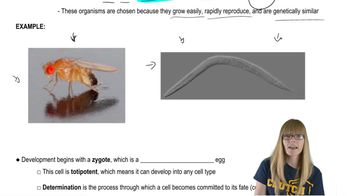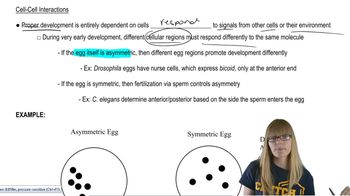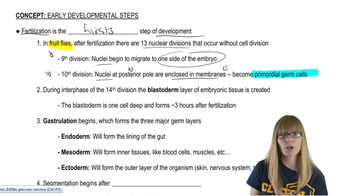Table of contents
- 1. Introduction to Genetics51m
- 2. Mendel's Laws of Inheritance3h 37m
- 3. Extensions to Mendelian Inheritance2h 41m
- 4. Genetic Mapping and Linkage2h 28m
- 5. Genetics of Bacteria and Viruses1h 21m
- 6. Chromosomal Variation1h 48m
- 7. DNA and Chromosome Structure56m
- 8. DNA Replication1h 10m
- 9. Mitosis and Meiosis1h 34m
- 10. Transcription1h 0m
- 11. Translation58m
- 12. Gene Regulation in Prokaryotes1h 19m
- 13. Gene Regulation in Eukaryotes44m
- 14. Genetic Control of Development44m
- 15. Genomes and Genomics1h 50m
- 16. Transposable Elements47m
- 17. Mutation, Repair, and Recombination1h 6m
- 18. Molecular Genetic Tools19m
- 19. Cancer Genetics29m
- 20. Quantitative Genetics1h 26m
- 21. Population Genetics50m
- 22. Evolutionary Genetics29m
14. Genetic Control of Development
Early Developmental Steps
Problem 11
Textbook Question
In gain-of-function let-23 and let-60 C. elegans mutants, all of the vulval precursor cells differentiate with 1° or 2° fates. Do you expect adjacent cells to differentiate with 1° fates or with 2° fates? Explain.
 Verified step by step guidance
Verified step by step guidance1
Understand the role of let-23 and let-60 in C. elegans vulval development. These genes are part of the signaling pathway that determines cell fate.
Recognize that gain-of-function mutations in these genes lead to overactive signaling, causing all vulval precursor cells to adopt 1° or 2° fates.
Recall that in normal development, the primary (1°) fate is typically adopted by the cell closest to the anchor cell, while secondary (2°) fates are adopted by adjacent cells.
Consider that in gain-of-function mutants, the signaling is enhanced, potentially leading to more cells adopting the 1° fate due to increased signaling strength.
Conclude that in these mutants, adjacent cells are more likely to differentiate with 1° fates due to the overactive signaling pathway, although some may still adopt 2° fates depending on the strength and reach of the signal.
Recommended similar problem, with video answer:
 Verified Solution
Verified SolutionThis video solution was recommended by our tutors as helpful for the problem above
Video duration:
2mPlay a video:
Was this helpful?
Key Concepts
Here are the essential concepts you must grasp in order to answer the question correctly.
Vulval Development in C. elegans
In C. elegans, vulval development is a well-studied process involving a specific pattern of cell differentiation. The vulval precursor cells (VPCs) are influenced by signaling pathways that determine their fates as either primary (1°) or secondary (2°) vulval cells. Understanding this process is crucial for predicting how adjacent cells will differentiate in response to mutations.
Recommended video:
Guided course

Genetics of Development
Gain-of-Function Mutations
Gain-of-function mutations result in a gene product with enhanced or new functions. In the context of let-23 and let-60 mutations in C. elegans, these mutations lead to increased signaling that promotes the differentiation of VPCs into vulval fates. This altered signaling can affect neighboring cells, potentially leading to a uniform differentiation pattern among adjacent cells.
Recommended video:
Guided course

Functional Genomics
Cell Signaling and Fate Specification
Cell signaling plays a critical role in determining cell fate during development. In C. elegans, the interaction between VPCs and surrounding cells through signaling pathways influences whether they adopt 1° or 2° fates. In gain-of-function mutants, the enhanced signaling may lead to adjacent cells adopting similar fates, which is essential for understanding the expected outcomes in the given scenario.
Recommended video:
Guided course

Cell-cell interactions

 3:46m
3:46mWatch next
Master Drosophilia Development with a bite sized video explanation from Kylia Goodner
Start learningRelated Videos
Related Practice


